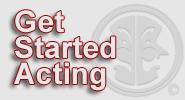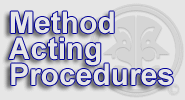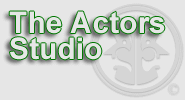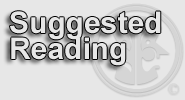|
|
|
| |
|
| |
|
| |
Suggested
Reading |
| |
For
those of you interested in studying more about "Method"
acting, Lee Strasberg and the Actors Studio, I have included the following
list of my favorite books on the subject, as well as a book or two on the business
end of acting. If you would like to purchase one or more of these books
online, please CLICK ON THE TITLE of the book(s). I used to make small commission but the Governor of Missouri fixed it so Amazon would no longer work with people in Missouri. I leave the books here anyway because they are important studies for serious actors.
|
|
by Nicole Comer
This charming and easy-to-read book is a candid, honest & no-nonsense guide for actors with an inside look into the acting “business”.
Most acting classes and drama schools teach the craft of acting, but they rarely cover the business. This book gives actors a road map to their career success.
A working actress, acting coach, writer and producer shares with you her tips, experiences, stories and reminders about the “business” to help take your career to the next level while always reminding the reader that acting is a business, so you had better put your big-girl and big-boy pants on!
|
 |
|
| |
|
Lola Cohen (Editor), Martin Sheen (Foreword)
The Lee Strasberg Notes reproduces the original teachings of a unique voice in actor training, for the very first time. It is a stunning document in the history and ongoing practice of Strasberg’s Method.
Compiled and edited by Lola Cohen, the book is based on unpublished transcripts of Strasberg’s own classes on acting, directing and Shakespeare. It recreates his theoretical approach, as well as the practical exercises used by his students, and brilliantly conveys his approach and personality.
The book features Strasberg’s teachings on:
•Training and exercises
• Characters and scenes
• Directing and the Method
• Shakespeare and Stanislavski
• The theater, acting and actors.
Including a Preface by Anna Strasberg and a Foreword by Martin Sheen, this illuminating book brings the reader closer to Strasberg’s own methods than any other, making it a phenomenal resource for students, actors, and directors. |
 |
|
|
By Sanford Meisner (Author), Dennis Longwell (Author), Sydney Pollack (Introduction)
This book, written in collaboration with Dennis Longwell, follows an acting class of eight men and eight women for fifteen months, beginning with the most rudimentary exercises and ending with affecting and polished scenes from contemporary American plays. Throughout these pages Meisner is delight--always empathizing with his students and urging them onward, provoking emotion, laughter, and growing technical mastery from his charges. With an introduction by Sydney Pollack, director of "Out of Africa" and "Tootsie," who worked with Meisner for five years. |
 |
|
|
By Uta Hagen
Part One, "The Actor," deals with the actor's concept of him or herself, as well as techniques that set an actor in motion physically, verbally, and emotionally.
Part Two, "The Object Exercises," offers specific and detailed work for the actor, covering a broad range of problems and circumstances, from making an entrance to using the Fourth Wall.
Part Three, "The Play and the Role," covers how to approach the play and identify with the character the actor will undertake. It also shares practical thoughts and answers the questions young actors ask most.
Uta Hagen's influence endures in many of today's most compelling stage and screen performances. Informative and inspiring, Respect for Acting will bring her timeless techniques to actors and audiences for years to come. |
 |
|
|
By
Stella Adler, Howard Kissel and Marlon Brando (Foreword)
Stella Adler was one of the 20th Century's greatest figures. She is arguably the most important teacher of acting in American history. Over her long career, both in New York and Hollywood, she offered her vast acting knowledge to generations of actors, including Marlon Brando, Warren Beatty, and Robert De Niro. The great voice finally ended in the early Nineties, but her decades of experience and teaching have been brilliantly caught and encapsulated by Howard Kissel in the twenty-two lessons in this book. |
 |
|
|
By
Konstantin Stanislavski
Stanislavski’s ‘system’ has dominated actor-training in the West since his writings were first translated into English in the 1920s and 30s. His systematic attempt to outline a psycho-physical technique for acting single-handedly revolutionized standards of acting in the theatre.
Until now, readers and students have had to contend with inaccurate, misleading and difficult-to-read English-language versions. Some of the mistranslations have resulted in profound distortions in the way his system has been interpreted and taught. At last, Jean Benedetti has succeeded in translating Stanislavski’s huge manual into a lively, fascinating and accurate text in English.
He has remained faithful to the author's original intentions, putting the two books previously known as An Actor Prepares and Building A Character back together into one volume, and in a colloquial and readable style for today's actors.
The result is a major contribution to the theatre, and a service to one of the great innovators of the twentieth century. |
 |
|
|
ACTING IS
EVERYTHING
An
Actor's Guidebook For A Successful Career In Los Angeles
|
by
Judy Kerr
This
really is the ultimate guidebook for actors who are determined to initiate and
sustain a successful acting career in Los Angeles or in their hometowns. Filled
with practical advice, Acting Is Everything helps beginners avoid scams so they
can get down to the business of getting work. Written by a renowned acting coach,
it helps actors do it right the first time, saving them time, money and heartache.
|
 |
| |
|
|
|
|
|
by Ron Gorow
This book is designed to help you develop and refine your perception and your ability to communicate with music—to know what you are hearing and to express your thoughts through music notation or performance.
In this book you will discover: Transcribing techniques. How to maximize your creativity and productivity. How to develop your craft by consolidating techniques. How to read music with your ears. How you can write music without using an instrument. How to write music spontaneously, as your ear guides your hand. How to communicate accurately through music notation. Why you don't need "perfect pitch." |
 |
|
| |
| ACTING OUT: Your Personal Coach to a Money-Making Career in Television Commercials |
by
Stuart Stone
A career plan for successful commercial actors Aspirants learn the elements, techniques, approaches, insider information and choices that raise them above others in the field. Today's widely-varied commercial spots--dramatic, dialogue-driven, beauty, comedy, niche, children, sports--offer myriad opportunities. Readers learn about:auditions, valuable trade secrets, how to get the perfect headshots, and much much more.
About the Author
Stuart Stone is a Canadian film, television, and voice-over actor as well as a producer of TV/film and music. Stone also has toured as a comedian and rapper. In March 2009, Stone was named one of the "10 most innovative on the web" for his work on The Sunday Nite Stu and his TSM Radio Show. |
 |
|
| |
| |
(translated by Elizabeth Reynolds Hapgood)
Theatre Arts Books
Stanislavski wrote this book to leave to the world a record of his approach to the actor's art. Basically, Tortsov, Artistic Director of a theatre, patiently guides his actors through an understanding of the many hidden resources at their disposal. It's obvious that "Tortsov" is actually Stanislavski, and the "students" are the company members of the Moscow Art Theatre. Very well written, easy to understand, laced with humor and humanity, every actor, regardless of his "method" owes it to himself to read this book. |
 |
|
| |
| |
by
Foster Hirsch
Da Capo Press
A most brilliant
history of the Actors Studio, by one of the world's foremost theatre historians,
with detailed chapters on the "life before the Studio", when Konstantin Stanislavski
started his lifelong quest for the answers to the questions that started it all.
This is one of the best books of its kind in print. If you're interested in the
history of the Actors Studio, you'll find this book salted with rich detail, peppered
with intuitive insight and sweetened with crystal clarity. Highly recommended. |
 |
|
| |
| |
Edited
by Robert Hethmon
Theatre Communications Group
As the title implies, this book is transcribed from actual
tape recorded sessions at the Actors Studio. It is a valuable resource for
those interested in "hearing" Lee Strasberg critique scenes in his own
distinguished way. The drawback, of course, is that the reader does not
have the advantage of having seen the scenes Strasberg critiques, but anyone with
a basic understanding of Strasberg's approach to actor training will gain
invaluable insights into problems that have plagued actors throughout the history
of the art. To help with that basic understanding, editor Robert Hethmon
has included his own descriptions and analyses of the basic elements of Strasberg's
"Method" with such clarity that the book is worth reading for that reason
alone. |
 |
|
| |
|
by
Richard Boleslavski
Theatre Arts Books
Richard Boleslavski,
with whom Strasberg studied (saving his notes from class his entire lifetime)
assumes a fictional role in this book as a teacher helping a young student address
the problems encountered by actors in their life in art. A beautifully
written book, laced with humor and invaluable insight. After reading this
book, actors might wonder if they need any more than these "lessons"
to accomplish their goals onstage. |
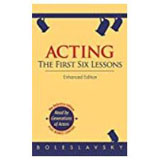 |
|
| |
|
|
| |
| |
Introduced
& Translated by David Magarshack
Faber & Faber
Long out of print, this book has been reissued.
The introduction by David Magarshack is one of the best (and longest) narratives
about Stanislavski and his work. It alone is worth the price of the book.
In the book, Stanislavki shares his genius with the reader as he writes about
"The System and Methods of Creative Art". This is also a great
book for students and professionals in Opera, as the master teaches acting for
that discipline here. |
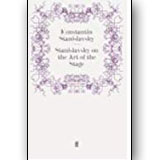 |
|
| |
| |
by
Edward Dwight Easty
Ivy Books
This book covers the basic fundamentals of the "Method":
Relaxation, Sense Memory and Concentration, as well as briefly touching on a few
other procedures (Affective Memory, Animal Exercise, Justification, etc.)
It is recommended as a quick-start primer for those who don't have enough
time to spend weeks reading the other books listed on this page. |
 |
|
| |
| |
|
by
David Garfield
MacMillan Publishing
Everything you want to know about the Actors Studio and
the people who brought the institution to the forefront of Western theatre excellence,
written intelligently by a sensitive and thoughtful insider. A "must
read".
|
 |
|
| |
by
Lee Strasberg
(Ed. Evangeline Morphos)
Strasberg's dream in his own words, published after
his death. Interesting reading, filled with insight. |
 |
|
| |
| ACTING: A HANDBOOK
OF THE STANISLAVSKI METHOD |
Compiled
by Toby Cole
Crown Publishers
With a brilliant introduction by Lee Strasberg, this book is a compilation
of essays, several by Stanislavski and one by his greatest student, Vakhtangov.
Also included is M. A. Chekhov essay, "Stanislavski's Method of Acting".
This book is an indespensable reference manual on the art of acting and directing.
I've had it since 1975, and refer to it often.
|
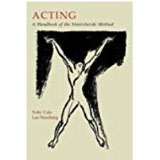 |
|
| |
 |
by
Constantine Stanislavski
Translated by Elizabeth Reynolds Hapgood
Theatre Arts Books
I've listed these two books together because they are strongly related in content,
and I feel that reading both these books one after the other might be a good way
to achieve absorbing the the limitless genius of the man who brought to the world
the first tangible means of approaching the problems inherent in the actors'
art. Reading these books make me realize how much we have lost in communication
as we immerse ourselves more deeply in the time consuming details of modern technology.
Stanislavski's wonderful command of language is not lost with Ms. Reynolds
translastions.
|
 |
|
| |
| |
By
Shelley Winters
Published by Outlet
Among the greatest actors of the 20th century, and one of the strongest advocates
of Lee Strasberg's "Method" acting, Shelley Winters gives invaluable
insights into the art of the actor and it's real life implications.
Told in autobiographical form, the wisdom harvested from these pages will serve
as a guiding light for all those who aspire to greatness in art. The honesty
of Ms. Winters revelations reflect the courage with which she has established
herself as a deeply moving artist who becomes totally involved in life and on
the stage. Very well written, filled with every shade of the emotional spectrum,
especially humor. Online Shelley
Winters Interview
|
 |
|
|
By
Shelley Winters
Among the greatest actors of the 20th century, and one of the strongest advocates
of Lee Strasberg's "Method" acting, Shelley Winters gives invaluable
insights into the art of the actor and it's real life implications.
Told in autobiographical form, the wisdom harvested from these pages will serve
as a guiding light for all those who aspire to greatness in art. The honesty
of Ms. Winters revelations reflect the courage with which she has established
herself as a deeply moving artist who becomes totally involved in life and on
the stage. Very well written, filled with every shade of the emotional spectrum,
especially humor. Online Shelley
Winters Interview |
 |
|
ACTORS ON ACTING
The Theories, Techniques, and Practices of the Great Actors Of All Times As Told
In Their Own Words |
Edited
with Introductions and Biographical Notes
by Toby Cole and Helen Krich Chinoy
Crown Publisher
The title says it all. This book is a must for every actor and serious student
of drama. From Ancient Greece to Modern times, every great actor and theory of
acting in the Western World is covered here. A veritable Encyclopedia of the greatest actors of all time.
|
 |
|
|
|
|
by Edward Dwight Easty (Author)
On Method Acting demystifies the "mysteries" of Method acting -- breaking down the various steps into clear and simple terms, including chapters on:
Sense Memory -- the most vital component of Method acting
Improvisation -- without it, the most integral part of the Method is lost
Animal Exercises -- just one way to combat the mental blocks that prevent actors from grasping a character
Creating The Outer Character -- so actors can give the freshness of originality to a role while at the same time living the life of the character
On Method Acting is also an indispensable volume for directors, designers, lighting technicians, and anyone in the dramatic arts interested in creating a believable and realistic effect in their productions. |
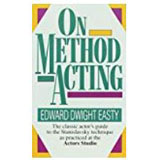 |
|
| |
©
TheatrGROUP, Inc. 1997-2015 |




